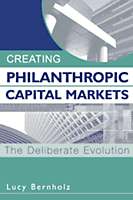The fracturing effects of infrastructure
I've been thinking about the organizations that support philanthropy for a long time. Called the infrastructure by some, these groups mostly consist of membership associations that provide networking, research, some connections to policymakers and a small, relatively quiet voice on behalf of nonprofit institutional philanthropy.
What is nonprofit institutional philanthropy, you ask, and why does it have its own infrastructure? I¡¦ll answer the first question first. Nonprofit institutional philanthropy refers to tax-exempt entities that exist to make philanthropic contributions available to society, either by making grants or by operating programs supported by the income earned off of an endowment. Essentially, they come in a couple of different flavors:
- public foundations,
- independent foundations,
- community foundations,
- corporate foundations, and
- operating foundations.
There are 65 ¡V 70,000 organizations that fall into these categories in the United States. Not too long ago, this short list constituted not only a part of the landscape for institutional philanthropy, but most of it.
This is no longer the case. Commercial vendors of financial products focused on philanthropy have proliferated, the most well-known being Fidelity Investments Charitable Gift Fund, a pre-teenager born in 1992 that now ranks as one of the nation¡¦s largest philanthropic institutions. Philanthropy has become a leading product line for the nation¡¦s financial firms. Heavily advertised, philanthropic products are an important instrument in helping these banks and fund management firms provide ¡§full-service¡¨ to their most sought after clients, the wealthy. The vendors of these products constitute the commercial side of institutional philanthropy. Although the number of institutions on this side of the aisle is much lower than the number on the nonprofit side, the assets being managed and the numbers of donors choosing products from the commercial vendors have been growing rapidly since first introduced. In fact, evidence is increasing that the customers who use the products offered by institutional philanthropy - both nonprofit and commercial ¡V are increasingly likely to have accounts with both types of vendors.
So why does nonprofit institutional philanthropy have its own infrastructure? It is certainly not the fastest growing segment of philanthropy. Despite the numbers of foundations and the size of their annual giving (~$40BB US in 2002), they still pale in comparison to the size of giving done without benefit of any institution. More than 80% of the giving in the United States (or more than $192 BB US) comes from individuals giving by themselves directly to the organizations or causes they care about most.
ramble ramble lost in the woods here?
How will standards set back the field?
How will the exclusivity of certain CF¡¦s lead to fracturing?
The unintended consequences of standards
Bookmark this on Del.icio.us




